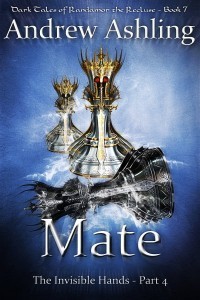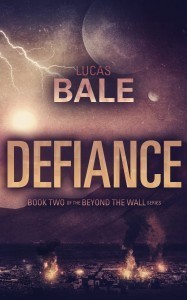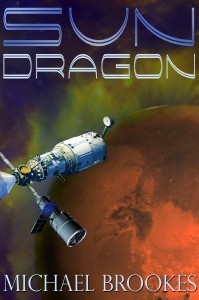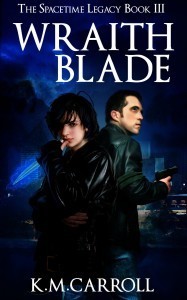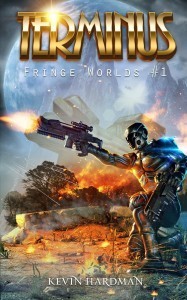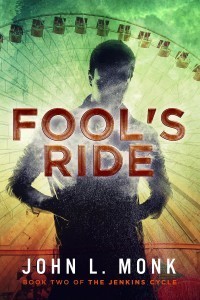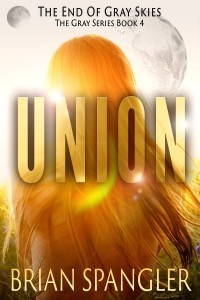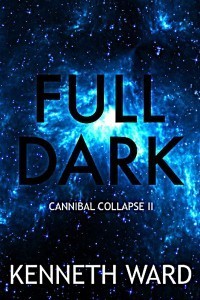Cora Buhlert's Blog, page 111
December 21, 2014
Little Lord Fauntleroy, A Christmas Carol and seasonal morality plays
Since it’s the run-up to Christmas, I’ve been watching favourite holiday movies, as they show up on TV. And so I ended up watching the 1980 adaptation of Little Lord Fauntleroy, starring Alec Guiness and Ricky Schroder, back to back with A Muppets Christmas Carol, starring Michael Caine and – well – the Muppets.
Now here in Germany, the 1980 adaptation of Little Lord Fauntleroy is a true holiday classic with a status much like that of It’s a Wonderful Life in the US (and a much better film IMO, but then I don’t like It’s a Wonderful Life very much). It’s that movie that’s always on TV during the run-up to the holidays somewhere and even though you’ve seen it a hundred times before, you still watch it anyway. A Muppets Christmas Carol doesn’t have the same classic status, though you can usually find several versions of A Christmas Carol on TV around the holidays and the Muppet version is a personal favourite of mine.
But watching both movies back to back, I was struck by how many parallels there are between both stories beyond the fact that both are based on classic works of Victorian literature, Charles Dickens’ A Christmas Carol, first published in 1843, and Frances Hodgson Burnett’s Little Lord Fauntleroy, first published in 1885, respectively.
In essence, A Christmas Carol and Little Lord Fauntleroy are both stories of grumpy old misers, Ebenezer Scrooge and the Earl of Dorincourt respectively, both played by distinguished British actors, Sir Alec Guiness and Michael Caine respectively, who learn about the spirit of generosity, compassion and of course the Christmas season via their exposure to sweet and angelic little boys, Tiny Tim and Ceddie Errol, Lord Fauntleroy, respectively. In Scrooge’s case, there’s also some significant supernatural intervention, probably because Scrooge is a more hardened case than the Earl of Dorincourt. Besides, Ceddie has more time to soften up his grandfather, since the novel spans several months rather than a single night like Dickens’ novella.
Both stories are basically Victorian morality plays about the importance of compassion and generosity towards the less fortunate. It’s a message that the Victorians age with its appalling living conditions for the poor, particularly poor children, needed to hear and it’s a message we’re still willing to listen to (and also need to hear on occasion), even though both Charles Dickens and Frances Hodgson Burnett drive it home with a somewhat heavier hand than a modern author would.
Nor are they the only popular holiday tales that praise generosity and compassion and tell of the transformation of a grumpy, unpleasant person, usually a man, into a happier and more open person. Indeed, this is the theme of a lot of classic holiday movies.
Die Zürcher Velobung (Engagement in Zurich a.k.a. The Affairs of Julie) from 1957, starring Liselotte Pulver, Paul Hubschmid and Berhard Wicki, is not just a lovely holiday movie (which for some reason is never on over the holidays) but also one of my favourite romantic comedies of all time. Again we get the transformation of a grumpy killjoy, film producer “Büffel” (buffalo) as played by Bernhard Wicki, into a more open and loving person, though Büffel has more of a reason to be grumpy than either Scrooge or the Earl, namely the fact that he’s a widower and single dad and has a mean toothache when we first meet him besides. Büffel’s transformation comes courtesy of Juliane (Liselotte Pulver), a struggling writer who moonlights as a dentist’s assistant, who in turn learns that romantic fantasies are just that, fantasies, and that sometimes Mr. Tall, Dark, Handsome and Swiss (Paul Hubschmid, being tell, dark, handsome and Swiss) isn’t necessarily Mr. Right. There’s the requisite cute kid as well, Büffel’s son played by a very young Roland Kaiser. Plus, the film also manages to subvert classic romance tropes and skewer the tropes of postwar West German cinema. Simply marvelous and also surprisingly risqué for the 1950s with clear hints of premarital sex and Juliane sharing a bed with both her suitors at one point (alas, the scene is entirely chaste). The film itself isn’t online sadly, but here is a trailer. There’s a 2007 remake, too, starring Christoph Waltz before he went to Hollywood and started playing Nazis and other villains for Tarantino, but it can’t hold a candle to the original.
Another holiday favourite of mine, We’re No Angels from 1955, starring Humphrey Bogart, Peter Ustinov and Aldo Ray, tells the story of three escapees from Devil’s Island who hide out in the home of a beleagured shopkeeper and his family, end up saving the family from financial ruin and find themselves transformed into better people in the bargain. There even is a miserly villain, though he gets killed courtesy of Aldo Ray’s pet snake rather than transformed.
And even that popular American classic It’s a Wonderful Life is a movie that sings the praises of compassion and generosity, because both are what makes James Stewart’s character, the world’s worst banker with the possible exception of his flat out crazy uncle, a person whose life is nonetheless valuable and worth saving. Though like We’re No Angels, It’s a Wonderful Life has zero interest in saving and transforming resident villain and grumpy miser Mr. Potter. Indeed, it’s telling that the two variations on the popular theme that are pure Hollywood products rather than Hollywood movies based on classic novels, punish rather than save their miserly villains.
Of course, not all holiday movies fall into this pattern. For example, Love Actually, Three Hazelnuts for Cinderella and Christmas in Connecticut don’t, even though they’re all beloved holiday classics.
But nonetheless it is interesting that around the holidays, we seem to crave stories, even heavily moralistic stories, about unpleasant people transformed into better people. Maybe it’s the secret hope that like Scrooge or the Earl of Dorincourt or Büffel or the three convicts of Devil’s Island we, too, can become better people and find love and companionship due to a good dose of Christmas magic.
 Send to Kindle
Send to Kindle
December 20, 2014
New release announcement No. 3: A German holiday romance – Neue weihnachtliche Liebesgeschichte erhältlich: Last-Minute Geschenke
This is the third of the pre-Christmas new release announcements. This time around, it’s for the German edition of last year’s short holiday romance Christmas Gifts, so let’s switch to German right away:
***
Nach zwei Ankündigungen für die englischsprachigen Leser gibt es jetzt auch noch etwas für die Fans deutschsprachiger Texte, nämlich eine Liebesgeschichte, die mitten im vorweihnachtlichen Shoppingtrubel spielt.
Das wundervoll winterliche und romantische Coverbild stammt übrigens von der russischen Künstlerin Ekaterina Kokushkina.
Last-Minute Geschenke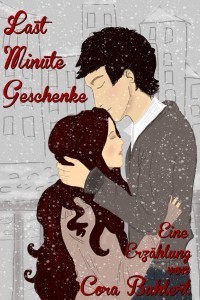 Bis kurz vor Ladenschluss am Heiligabend zu warten, um ein Geschenk für seine Mutter zu besorgen – das war sicherlich nicht eine von Tims besseren Ideen. Und dann hat der Laden auch noch eine Selbst-Einpackstation, wo Tim doch vom Geschenke Einpacken keine Ahnung hat.
Bis kurz vor Ladenschluss am Heiligabend zu warten, um ein Geschenk für seine Mutter zu besorgen – das war sicherlich nicht eine von Tims besseren Ideen. Und dann hat der Laden auch noch eine Selbst-Einpackstation, wo Tim doch vom Geschenke Einpacken keine Ahnung hat.
Glücklicherweise begegnet er der unkonventionellen Shannon, die ihm ihre Hilfe anbietet.
Mehr Informationen zur Geschichte gibt’s hier.
Preis: 0,99 EUR, USD oder GBP
Erhältlich bei Amazon Deutschland, Amazon USA, Amazon UK, Amazon Niederlande, Amazon Frankreich, Amazon Italien, Amazon Spanien, Amazon Canada, Amazon Australien, Amazon Brasilien, Amazon Mexico, Amazon Japan, Amazon Indien, Kobo, Apple iTunes, Thalia, Weltbild, Hugendubel, Der Club, BOL, Otto-Media, Donauland, buecher.de, buch.de, eBook.de, Barnes & Noble, Scribd, txtr, Inktera, Smashwords, Casa del Libro, Flipkart, e-Sentral und XinXii.
Dieses Buch gibt es auch auf Englisch.
 Send to Kindle
Send to Kindle
December 19, 2014
New release announcement No. 2: Boardwalk Baby
As I said yesterday, I’ll be posting a trio of new release announcements in the run-up to the holidays and here is number 2. This time, it’s for a new fantasy novelette called Boardwalk Baby.
Boardwalk Baby is the result of one of those true sparks of inspiration. It began with a phenomenon that is well known here on the North Sea coast, namely that of abandoned seal pups, known as “Heuler” (howlers) in German, because they sound like crying babies. See this video. Orphaned and abandoned seal pups are collected and raised in several seal stations along the Dutch and German North Sea coast.
Suddenly, a thought occurred to me: If selkies are seal shifters, does that mean that there are selkie “Heuler”? And what would happen if humans were to find and raise such a baby selkie?
The result was the story of Izzy, an adopted kid with a lifelong affinity for the sea, who goes in search of her origins and finds more than she bargained for.
In the end, I decided to set Boardwalk Baby in the US rather than in Germany or the Netherlands, because the story worked better within the framework of the US adoption system rather than the German system, which is quite different. Besides, Ocean City is a lot cooler than the dull German seaside resorts and it allowed me to allude to the curious phenomenon of “infant incubators” as sideshow attractions in US seaside resorts in the early 20th century. There is an article about the “infant incubators” and their history here, though sadly the author can’t stop him- or herself from getting in a jab against abortion at the end.
So check out Boardwalk Baby, the story of a foundling selkie and her search for her roots:
Boardwalk Baby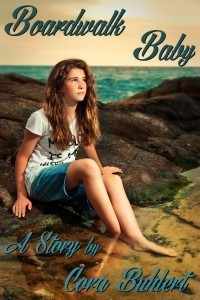 There are two things about herself that Izzy has always known with absolute certainty: One, that she was adopted and two, that she has an affinity for the sea. For from her earliest memories on, the ocean has always called out to Izzy. But her adoptive parents thwart her attempts to get closer to the sea at every turn.
There are two things about herself that Izzy has always known with absolute certainty: One, that she was adopted and two, that she has an affinity for the sea. For from her earliest memories on, the ocean has always called out to Izzy. But her adoptive parents thwart her attempts to get closer to the sea at every turn.
When Izzy turns eighteen, she goes in search of her past and her birth family. It’s a quest that will take her to the boardwalk of Ocean City, New Jersey, and to a mysterious fur coat that might hold all the answers to Izzy’s questions.
For more information, visit the Boardwalk Baby page.
Buy it for the low price of 2.99 USD, EUR or 1.99 GBP
at Amazon US, Amazon UK, Amazon Germany, Amazon France, Amazon Netherlands, Amazon Spain, Amazon Italy, Amazon Canada, Amazon Australia, Amazon Brazil, Amazon Japan, Amazon India, Amazon Mexico, Kobo, Barnes & Noble, Apple iTunes, Scribd, Smashwords, Inktera, txtr, Thalia, Weltbild, Hugendubel, Der Club, Libiro, Nook UK, DriveThruFiction, OmniLit/AllRomance e-books, Casa del Libro, Flipkart, e-Sentral, You Heart Books and XinXii.
 Send to Kindle
Send to Kindle
December 18, 2014
New Free Anthology Available – Stories on the Go: 101 Very Short Stories by 101 Authors
I’ll have several announcements to make in the next few days, because I have not one but three new books out. But don’t worry, this blog won’t turn into wall to wall promotion. It’s just a case of weird timing.
The first project I want to announce is massive anthology that was over a year in the making. And while we’re on the subject of anthologies, I also want to introduce you to the brand-new Anthology page on this site, which lists all anthologies to which I have contributed.
Stories on the Go: 101 Very Short Stories by 101 Authors does exactly what it says on the tin. It’s an anthology of 101 flash fiction stories across different genres and styles by 101 different indie authors. The anthology was sparked by an idea by Hugh Howey (who also contributed a story) and was edited by Belgian writer Andrew Ashling, who writes some cracking good epic fantasy with gay protagonists, when he’s not editing anthologies.
The anthology was intended as a sampler for the breadth of genres and styles found in indie publishing. So whatever your reading preferences, you’re certain to find something in there you’ll enjoy. And who knows, you might just discover a new favourite writer.
Best of all, Stories to Go is available for free at most major e-book vendors. Yes, you read that correctly. The anthology is free (or 99 cents at those Amazon stores that couldn’t be bothered to pricematch). So what are you waiting for? Pick up your copy now!
Stories on the Go: 101 Very Short Stories by 101 Authors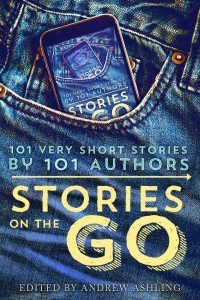 This anthology aims to be a showcase of recent indie writing.
This anthology aims to be a showcase of recent indie writing.
Hugh Howey launched the idea on Kboards, a forum for Kindle readers, but also the meeting place of an active community of indie writers.
The result is this anthology of 101 very short stories by 101 authors.
To make it more attractive for you, the reader, we set ourselves a limit of a thousand words. You should be able to read each story in under five minutes — on your desktop computer, laptop, or tablet at home or in the office, but also on your smartphone, on the go, while you are commuting or waiting at a coffee shop for your significant other to arrive.
We included as many genres as we could. We hope that maybe, with only five minutes of your time on the line that would otherwise be wasted anyway, you’ll be tempted to venture outside your comfort zone and try out some new genres and new authors.
Stories by: Micah Ackerman, Caddy Rowland, Monica La Porta, Sam Kates, Lanette Curington, Ela Lond, Livia Harper, Griffin Carmichael, Selina Fenech, Mark Gardner, Ellisa Barr, Marilyn Vix, Jean Louise, Sheryl Fawcett, Nathan Williams, K.D. Hendriks, Wendy C. Allenn (Eelkat), Lindy Moone, Andrew Ashling, David J. Normoyle, Jack Lusted, H.S. Stone, Craig Halloran, Cherise Kelley, George Berger, Jamie Campbell, Amelia Smith, H.S. St.Ours, Melisse Aires, Cora Buhlert, Philip Harris, Emily Martha Sorensen, Raquel Lyon, Samuel Clements, Dulce Rolindeax, Julie Ann Dawson, J.T. Hall, Roz Marshall, Vincent Trigili, J.E. Taylor, Hugh Howey, Samuel Peralta, Daniel R. Marvello, John L. Monk, Hudson Owen, Stella Wilkinson, Susan C. Daffron, Anya Kelly, Rachel Aukes, Anya Allyn, Zelah Meyer, Nicolas Wilson, Jennifer Lewis, Toni Dwiggins, Derek Neville, D.D. Parker, Keith Rowland, Ruth Nestvold, P.D. Singer, Quinn Richardson, Peter J. Michaels, Daniel Wallock, Thea Atkinson, Lisa Grace, Matt Ryan, Vanna Smythe, Geraldine Evans, MeiLin Miranda, Beverly Farr, Sarah L. Carter, Tony Bertauski, Edward M. Grant, Misti Wolanski, Erik Feka, Dee Gabbledon, Becca Price, Arrington Flynn, L.E. Parin, Darrin Perrez, Frank Zubek, Rachel Elizabeth Cole, Matthew W. Grant, Michael Coorlim, Maren Hayes, Tony Held, Allan Körbes, Tiffany Cherney, Landon Porter, Kathy Molyneaux, Drew Avera, SB Jones, Bob Summer, E.A. Linden, Sarra Cannon, Carol Kean, Kristy Tate, Jos van Brussel, John March, Nadia Nader, R.M. Prioleau, Joel Ansel
Get it for FREE at Amazon US, Amazon UK, Amazon Germany, Amazon France, Amazon Netherlands, Amazon Spain, Amazon Italy, Amazon Canada, Amazon Australia, Amazon Brazil, Amazon Japan, Amazon India, Amazon Mexico, Kobo, Barnes & Noble, Apple iTunes, Scribd and Inktera.
****
My own contribution to the anthology is called “Heiligenloh”. It’s a contemporary romance set in this lovely North West German village.
I found the real Heiligenloh in much the same way that my hero Marco finds it, because of a detour due to the road closure while I was on my way to my teaching job at the University of Vechta. Humpe’s grocery store is a real place, too, and one where I frequently stopped for some groceries on the way home. Alas, the romance is entirely fictional.
 Send to Kindle
Send to Kindle
December 17, 2014
Seasonal Views of Bremen 2014
This holiday season I mostly found myself tied to the house due to ongoing construction work. Which isn’t that much of a problem, since I do most of my holiday shopping online anyway.
However, yesterday there was a lull in the construction work, so I took the chance for a stroll over the Bremen Christmas Market. And since the weather was decent, I took my camera along:

Heading for the Christmas Market. In the background you can see Bremen townhall and the St. Petri Dom church. In the front, you’ve got Christmas lights in the shape of the Bremen town musicians at the entrance to the main shopping street Obernstraße. The lines crisscrossing the photo are the contact wires for the tram.

Bremen’s Renaissance townhall, a Unesco World Heritage site, with the Church of Our Lady in the background and the Christmas market in the foreground.

The giant Roland statue on the market square overlooks a stand selling gingerbread hearts. The Roland depicted here is the heroic knight from the “Chanson de Roland”. According to an old legend, the Roland statue guarantees Bremen’s independence.

A look across the roofs of the Christmas market at the Romanesque St. Petri Dom, the city’s main cathedral. The modern building on the right is the seat of the Bremen state parliament, a rather unfortunate 1960s design.

Here is the state parliament building again, with a giant nutcracker adding some seasonal cheer.

A giant Christmas tree stands in a corner of the market square.

Gilded puttos adorn the Baroque guild hall “Schütting”.
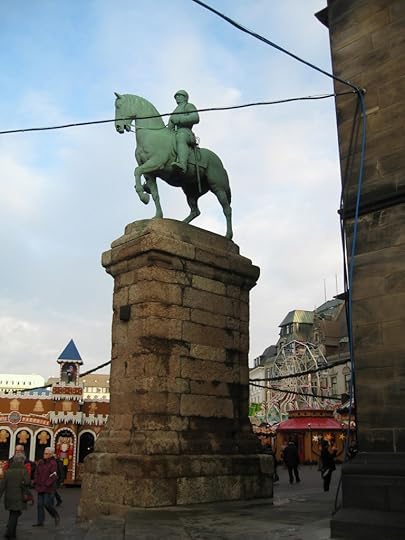
Otto von Bismarck, the iron chancellor, overlooks the Christmas market from his plinth next to the St. Petri Dom church.

These market stands are almost exact reproductions of notable buildings in the medieval Schnoor neighbourhood. The originals are maybe 500 meters away.

This beautiful life-size nativity scene sits nestled against the massive walls of the St. Petri Dom.

A seasonally decked out ferris wheel with the former headquarters of the Bremer Bank, now a Commerzbank branch in the background.

The “Happy Sailor”, a vintage carousel from the 1960s, is something of a Bremen institution. The regular design has been updated for Christmas.

This animatronic moose sings Christmas carols and is one of the highlights of the Christmas market.
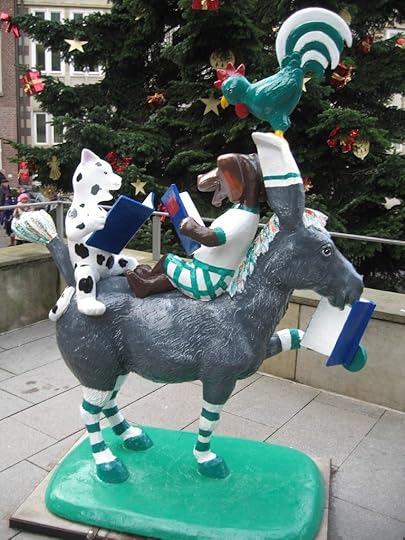
The Bremen town musicians from the Grimm brothers’ fairytale have left their mark all over the city. Here is a modern fibreglass statue of the town musicians reading, while sporting the colours of the local football club Werder Bremen. Note the massive Christmas tree in the background.
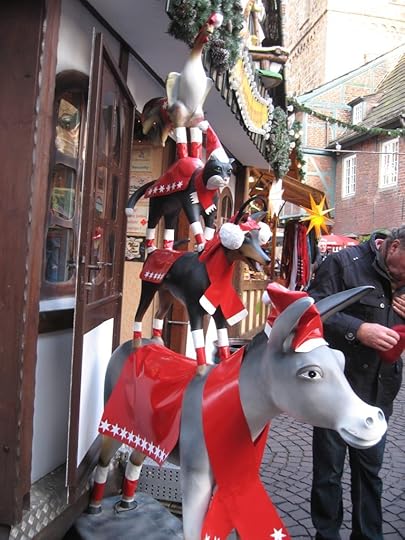
And once again, the Bremen town musicians in festive dress.

Town musicians the third, this time silhouetted as Christmas lights in front of the St. Martini church.

Originally, the Christmas Market was confined only to the market square and neighbouring St. Petri churchyard, but in recent years it has spilled out across the city, such as this pirate themed market along the river Weser.

Pirates need a ship and luckily the “Admiral Nelson”, a restaurant vessel, is moored at the Weser quay.

This stall by the riverside sells birdhouses. In the background, you can see the Museum Weserburg, a modern art museum. The highrise building in the far background is the headquarters of the chocolate and coffee manufacturer Kraft Jakobs Suchard on the other side of the river.

More evidence that the Christmas market has spilled out all over the city is provided by this giant Christmas pyramid in front of Bremen central station.

This stand inside Bremen central station sells doughnuts. Unfortunately, whoever set this up was seriously spelling challenged and misspelled doughnuts/donuts as “donazz”.

Not really Christmassy, just beautiful: A spectacular light sculpture spanning five floors in the Galeria Kaufhof department store, formerly Horten. Store and sculpture were built in 1972.
 Send to Kindle
Send to Kindle
December 15, 2014
Mixed updates and more on hard SF and messy emotions
First of all, I’ve been interviewed by British crime fiction writer J.T. Baptiste for the 12 days of crime series on her blog. We talk about writing, reading, favourite characters, Edgar Wallace movies and Dr. Mabuse, who is one of my all-time favourite villains. Also keep checking back, because a new interview with a crime fiction writer will be posted every day until Christmas. Up today is John Hindmarsh.
Over at the Pegasus Pulp blog, I’ve also been talking about pulp speed and writing like the pulp writers of old.
In the meantime, Tuesday’s post about hard SF and messy emotions seems to have struck a nerve, because it sent my blog stats through the roof, largely due to links by the excellent blogs Dear Author, SF Signal and The Galaxy Express. Meanwhile, I was dealing with translation rush jobs, incapable workmen building a garage and also sort of vanished into putting the finishing touches on what will be the last two e-book releases of the year for me (official announcement coming soon), so I missed much of that.
However, the discussion didn’t stop, so here are some more links:
Angela Highland responds at her blog here. It’s certainly interesting how many of us had similar experiences in our relationship to romance. We bounced off the genre during the “bodiceripper” era, turned to SFF and finally came back fifteen years or so later to find that the romance genre had changed.
Coincidentally, I also find that for the past few years, the majority of SFF that I’m reading was written by women (and the occasional non-binary person), because in books by women I can usually find well-written female characters and the chance of coming across misogynist fuckwittery is much lower. It’s not that I don’t read SFF written by men, because I certainly do. But mostly I find that they’re either books by men I’ve been reading for years or whom I know personally or books that come highly recommended from trusted sources.
Athena Andreadis pointed me to this older post on her blog about hard science fiction and how it’s often not very scientific and also focusses only on particular sciences, namely physics and computer science, while e.g. biology is ignored, which explains why e.g. Larry Niven is considered a writer of hard SF, while Lois McMaster Bujold or Joan Slonczewski are not. As always, she makes some excellent points, including the what passes for hard SF these often fails on every other storytelling front.
As a matter of fact, the jargon-heaviness and info-dumpiness of bad hard SF has also begun to affect other genres and subgenres by now. A lot of post-apocalyptic fiction, particularly the subgenre known as “prepper fiction”, expounds in great and exhaustive detail on the specs of guns, ammo and – less frequently – water purifiers to the point that a disagreement about a rifle scope almost led to a law suit. Meanwhile, certain Tom Clancy thrillers read like manuals for submarines and other military hardware to the point that I once said, “I translate tech specs for a living, so I’m certainly not reading them in leisure time unless I get paid for it.”
Meanwhile, Australian SFF writer Patty Jansen (who among other things also writes hard SF that’s actually good) sticks up for the romance genre and points out that writing contemporary romance is a great skill and that every writer should try it at least once, even if they never plan on publishing it. Because the fact that contemporary romance sticks to the “dull” mundane world (which isn’t necessarily all that dull, since I’ve read some great contemporary romance in fascinating settings that I knew little to nothing about) means that it’s a great way to learn about creating rounded and believable characters and relationships. And SF could certainly use more of that.
Kate Elliott also pointed out this post by Jared Shurin at Pornokitsch about five things that epic fantasy could learn from historical romance. Once again, this is a post by someone who either isn’t very familiar with the (historical) romance genre or at least hasn’t read it in a while and then suddenly comes (back) to the genre and finds a whole lot to enjoy there. I also find his comments on the different structure of series in SFF and romance interesting, because they very much mirror my own experiences upon returning to the romance genre.
I second his point on historical romance having women with agency rather than harping on “But this is historically accurate, because all women were chattel in the Middle Ages” like some authors of epic fantasy tend to do – never mind that it isn’t even true. Though he is mistaken that women in historical romance only exist to have sex. First of all, there are whole romance subgenres out there which do not have explicit sex (e.g. traditional regencies and Christian romances, many of which are historicals) and secondly, romance is a female-focussed genre where the main protagonist is normally the heroine. In fact, you could argue that the hero only exists so the heroine has someone to fall in love and have sex with, though in truth the heroes are usually well developed characters with lives, interests, adventures and families (brothers, lots of brothers) of their own.
I also agree with him about the sex, though not every romance subgenre contains the same amount of sex or even any sex at all. Not that historical romance sex can’t be a tad ridiculous (sheltered virgins experiencing multiple orgasms and giving oral sex on their first night out – not very likely), but at least the sex is mostly consensual (some rapey old-school “bodicerippers” notwithstanding) and generally depicted as a positive experience. Whereas certain epic fantasies of the grimdark kind make me wonder whether anybody in these worlds ever had regular consensual sex without money being exchanged and whether any woman in those worlds ever actually enjoyed sex.
Finally, just to prove that not all men are as enlightened with regard to romance as Jared Shurin, last week a prominent male author declared that he had personally revolutionised and reinvented the erotica romance genre. Unsurprisingly, several women disagreed and hijincks ensured.
 Send to Kindle
Send to Kindle
December 8, 2014
Of Hard SF and Messy Emotions
At the newly launched Uncanny Magazine, Tansy Rayner Roberts asks “Does sex make science fiction ‘soft’?” Found via Pretty Terrible, the site formerly known as The Radish.
Now the debate about whether romance subplots water down science fiction is nothing new. It rears its ugly head every couple of months. Here is one example from last year.
Nonetheless, this article is a good addition to the ongoing debate, because Tansy Rayner Roberts raises several important points such as that SF by female authors is far more likely to be dismissed as “soft” or “not really SF at all” for romantic subplots than similar works by male authors. Hence Lois McMaster Bujold or Catherine Asaro or Ann Aguirre are dismissed for writing romance, while Simon R. Green is not, even if Green has romantic subplots in his SF novels and Bujold’s or Asaro’s SF is a lot harder than Green’s, whose space opera series has vampires, werewolves, zombies and swordfights. Meanwhile, Robert A. Heinlein, Poul Anderson, Alfred Bester, Frank Herbert, Edmund Hamilton and plenty of other classic SF writers can have sex and relationships in their books and yet the hardness of their fiction is never in question.
Indeed, I’m finding the term “hard science fiction” increasingly problematic, especially since it often seems to refer to something other than “science fiction that is scientificall plausible when written”. And I love Tansy Rayner Roberts’ definition of what is considered “hard SF” and why for example Lois McMaster Bujold’s work is not normally considered “hard SF”, even though it contains a lot of science and speculates about scientific breakthroughs might impact society, including human relationships:
I’ve been around science fiction a long time now, and I’ve yet to hear a really good definition of “hard” science fiction that doesn’t come down to “Science is more interesting than people, yes really, look at that giant piece of machinery!”
This attitude is surprisingly common in the SF community, as this recent post at SciFi Ideas shows. The author clearly prizes scientific accuracy and the possibility of inspiring generations of future scientists above all else. Which is his prerogative, only that the reason that Star Trek or Asimov’s robot stories and novels inspired so many scientists is not just because the science was good for the time, but also because they told cracking good stories about worlds you wanted to live in with characters you wanted to meet.
Tansy Rayner Roberts also points out that it’s not necessarily men who do the dismissing, even though they make up a significant percentage of the dismissers, but women as well. I discuss an example of a woman writer dismissing romantic urban fantasy in this post from 2011. Here is an excerpt from that post:
It seems a lot of women have internalized the prejudices against women’s writing and female dominated genres and react by rejecting those labels for themselves, because they want to belong to the “right sort of club”. But while tearing down other women to gain acceptance from a usually male-dominated establishment may be seductive (I’ve done it myself, when I was younger and stupider), it doesn’t work. Because your status as “one of the guys” will only be at risk again next week, when you dare to like something they don’t like or reject something they do. Really, it’s better not to play that particular game, but call others (mostly men, but some women as well) out on their prejudices against certain genres and subgenres.
This explains why some of the most vehement bashing of romantic elements in speculative fiction comes from women. And indeed Tansy Rayner Roberts describes a similar experience:
Like many geek women, I grew up thinking of romance fiction as being a thing over there, while science fiction was this completely different thing over here. I gravitated towards science fiction and fantasy precisely because the works teenage girls were “supposed” to read had lost my interest.
I started reading romance fiction this year, for the first time, at the age of thirty–five. It’s not that I hadn’t read the occasional romance before, but this is the year that I actually Got It.
Between the ages of twelve and thirteen I put aside the several tons of Sweet Valley High and Sweet Dreams novels I had been inhaling and started on David Eddings, Jennifer Roberson, Terry Pratchett, Raymond E Feist, and Janny Wurts instead. I didn’t look back.
If I read more fantasy than science fiction, I don’t think I noticed that I found the stories more compelling because I was more likely to find a focus on friendships, sex, and relationships in between the magical adventure. I also don’t think I noticed that the science fiction I loved best did the same thing.
With a very few changes (I didn’t discover Terry Pratchett and Jennifer Roberson until later), this could have been me. I also devoured the Sweet Valley High teen romances, until I grew out of them and lost interest. For a year or two, I drifted between genres, unsure what to read next. I tried romances and family sagas, because they were available (My Mom had a lot of them) and because they were what grown-ups were supposed to read, at least if they were female.
So I read Catherine Cookson and Catherine Coulter and Judith Krantz and Shirley Conran and Victoria Holt and French writers Anne Golon and Elisabeth Barbier and German writers Uta Danella and Marie Louise Fischer.
I enjoyed some of these books such as Victoris Holt’s gothics, Anne Golon’s Angelique series as well as Elisabeth Barbier for a while, until her People of Mogador series went on and on and on and all the characters I liked were killed off (somehow it was not unlike the experience of reading A Song of Ice and Fire). Meanwhile, I bounced hard of the Anglo-American “bodicerippers” and glitzy romances of the era. I bounced even harder off German writers Uta Danella and Marie Louise Fischer and their genteel upper middle class tales of unhappy women living in big villas in Munich suburbs that might as well have been on Mars for all they had to do with my life. I suspect remembering the nasty conservative undertones of Marie Louise Fischer’s YA novels* certainly contributed to my rejection of her adult fiction, which actually contains a few genuinely interesting works like the Senta quartet, which chronicles the life of a young Berlin woman in the first half of the 20th century and does tackle tough subjects like the holocaust (Senta marries a Jewish lawyer). And I credit Uta Danella’s Alles Töchter aus guter Familie (All girls from good families), which was originally published in 1958, with teaching me that women sometimes bled during first time sex (“All that ickiness and then it hurts and you even bleed, too. No, no way, I’m never doing that!”)
Then, at the age of 15, I discovered science fiction and fantasy and never looked back. I also decided that I didn’t like romance novels, because romance novels were for those stupid girls in my class who cared for nothing but boys and make-up and dance classes. Oddly enough, I don’t recall that a single of those “stupid girls” actually read romances – they either read problem books about starving children in Third World countries (very popular in the 1980s) or problem books about the holocaust or Stephen King like everybody else.
Nonetheless, the idea that romance was a stupid genre for girly women stuck in my head, unexamined until I decided to give romance another try in my late 20s and found that I liked quite a lot of it. In the meantime, I also found that the SFF I enjoyed most usually included strong interpersonal relationships, whether romantic, family relationships or friendships, among all the speculative stuff. I also noticed that I didn’t like a lot of SFF novels that were highly praised and even won awards, because the characters were flat, relationships unbelievable, if they existed at all, and women just an interchangeable prize for our male hero. But romance? Nope, I don’t read that.
Of course, it didn’t help that my first exposure to the romance genre came via rapey “bodicerippers” (I have particularly shudder-inducing memories of a Catherine Coulter historical with a graphic whipping scene as well as Valentina by Fern Michaels), i.e. books I would no more like today than I liked them back then. I’m not actually sure how I would react to Marie Louise Fischer or Uta Danella, if I were to try to read them today (though I could, cause my Mom has a massive collection).
Nonetheless, when I came back to romance in my late 20s, I found that the genre had moved on, away from the “bodicerippers” or genteel marriage dramas of lonely women in Munich suburbs I remembered. I also found that I liked this new romance genre quite a bit. Even better, I discovered the wide spectrum of hybrid romance subgenres such as romantic suspense, paranormal romance, fantasy romance, science fiction romance, etc… and never looked back.
At the root of the anti-romance and anti-sex prejudice in large parts of the SFF community lies a deep discomfort with emotion. I’ve blogged about this before in 2011.
And indeed accusations of “This isn’t SFF” often broil down to “This story contains more emotion than I’m comfortable with”, since for some reason no one ever accuses stories about characters standing around in an SFF landscape and endlessly philosophizing about something or other of being “not SFF”. But if there’s a story that deals with relationships and emotions, even if the context is clearly speculative, then suddenly that story is accused of being not speculative enough. Bonus points if the author and/or POV characters are something other than straight white cis- and heterosexual men.
Here is a fairly recent example, in which a critic complains that some highly regarded and awards nominated short stories aren’t speculative enough for his tastes, because the speculative element takes a backseat to the inner lives of the characters. In short, they’re stories about emotions rather than ideas and such stories should be told in realist rather than speculative fiction.
Now I read and enjoyed all stories listed, and so it seems, did many others, because of the four stories mentioned, three ended up on this year’s Hugo ballot (the third is a 2014 story). I actually agree with the author that these stories are representative of a taste shift in short and maybe soon novel length fiction, a shift away from ideas and “Look, isn’t this big dumb object/alien world cool” towards stories about characters and relationships that just happen to be set in a speculative setting. Because there certainly are more stories of this kind to be found in short fiction venues and there have been for a couple of years now. It’s a shift I welcome, because while I like big SFnal ideas like the next girl, I also want to see believable characters and relationships with the cool genre furniture.
I also wonder whether this shift in reading tastes isn’t related to a shift in the broader demographics of the speculative fiction community. Because the SFF community has become a lot more diverse in recent years and so have its tastes.
Besides, it’s not as if big idea fiction and object porn is in danger of dying out. It’s still around, though it’s no longer as dominant as it once was.
*Marie Louise Fischer’s YA books were mostly about uppity teenagers being broken and turned into good little model housewives. I have particularly bad memories of Ist das wirklich Isabell? (Is this really Isabell?), first published in 1962. Years later I learned that Fischer also used to pen the sex and relationship advice column of the popular German teen magazine Bravo in the 1950s and 60s und used it to tell youn readers that same sex longings were sinful. Thankfully, she was replaced by the much more liberal Dr. Martin Sommer a.k.a. Dr. Martin Goldstein in 1969.
 Send to Kindle
Send to Kindle
December 5, 2014
Two new Helen Shepherd Mysteries available: A Bullet for Father Christmas and Paris Green
Just in time for St. Nicholas Day, I have two new stories in the Helen Shepherd Mysteries series to announce.
The first novelette is a holiday mystery called A Bullet for Father Christmas.
After the success of Christmas Gifts last year, I wanted to write another holiday story. However, I wanted to do something a little different this year, so I decided to write a holiday mystery instead of a holiday romance this year. And since I already had a mystery series with a steady cast of characters, it was a no brainer to make it a Helen Shepherd Mystery.
Of course, a Christmas mystery needed a plot, so I decided to come up with a holiday related crime and promptly had Santa Claus first turn to crime and then had him shot dead in the course of a robbery. Yes, I killed Santa Claus or rather Father Christmas in this story.
A Bullet for Father Christmas When two men dressed up as Father Christmas rob a London jewellery store and one of them ends up dead on the floor, shot by his own accomplice, it’s certainly one of the more unusual cases for Detective Inspector Helen Shepherd and her team. But as Helen begins to investigate, it turns out that the case is even more bizarre than she suspected.
When two men dressed up as Father Christmas rob a London jewellery store and one of them ends up dead on the floor, shot by his own accomplice, it’s certainly one of the more unusual cases for Detective Inspector Helen Shepherd and her team. But as Helen begins to investigate, it turns out that the case is even more bizarre than she suspected.
More information.
Length: 9300 words
List price: 2.99 USD, EUR or 1.99 GBP
Buy it at Amazon US, Amazon UK, Amazon Germany, Amazon France, Amazon Netherlands, Amazon Spain, Amazon Italy, Amazon Canada, Amazon Australia, Amazon Brazil, Amazon Japan, Amazon India, Amazon Mexico, Kobo, Barnes & Noble, Apple iTunes, Scribd, Smashwords, Inktera, txtr, Thalia, Weltbild, Hugendubel, Der Club, Libiro, Nook UK, DriveThruFiction, OmniLit/AllRomance e-books, Casa del Libro, Flipkart, e-Sentral, You Heart Books and XinXii.
But since the holidays are nigh and mysteries make good reading for those long winter nights, I promptly wrote another Helen Shepherd Mystery entitled Paris Green. If you know a bit about chemistry, the title gives a clue regarding the manner of death.
I got the idea for Paris Green from reading this article about the dark sides of Victorian fashion, a dark side which includes the fact that many of those gorgeous Victorian gowns were coloured with highly toxic dyes containing arsenic. I vaguely knew that many old pigments and dyes contained toxic substances and indeed “giftgrün” (poison green) is a common German name for bright green colours. But until reading that article I never realised how widespread that problem really was.
And considering that I worked in an antiques shop as a teenager, that was somewhat troubling. I’m still here obviously, but it’s highly likely that I had contact with dangerous substances at some point. And come to think of it, I did get quite ill while working there, after I had cleaned up some new acquisitions. At the time, I simply thought I’d caught some bug, but today I wonder…
That article not just caused me to take a long look at my personal collection of antiques (though most of my collection is not old enough to be a problem and the Victorian fashion plates that might contain poisonous dyes are kept safely under glass), it also bred a plot bunny along the lines of “What if antiques containing arsenic dyes were used to poison someone?”
Paris Green required quite a bit of research (particularly considering it was an eight hour challenge story), research that was both fascinating and unpleasant. Because it turns out that researching arsenic poisoning has the tendency to cause psychosomatic symptoms of arsenic poisoning.
Paris Green When intern Kitty Chan is found dead in the basement of the Victoria and Albert Museum, dressed in a Victorian ball gown, the cause of death is quickly established. Kitty died of arsenic poisoning. But who gave her the deadly dose and why?
When intern Kitty Chan is found dead in the basement of the Victoria and Albert Museum, dressed in a Victorian ball gown, the cause of death is quickly established. Kitty died of arsenic poisoning. But who gave her the deadly dose and why?
Detective Inspector Helen Shepherd investigates and quickly realises that there is more to this case than meets the eye.
Warning : There are some rude words in this story.
More information.
Length: 8500 words
List price: 2.99 USD, EUR or 1.99 GBP
Buy it at Amazon US, Amazon UK, Amazon Germany, Amazon France, Amazon Netherlands, Amazon Spain, Amazon Italy, Amazon Canada, Amazon Australia, Amazon Brazil, Amazon Japan, Amazon India, Amazon Mexico, Kobo, Barnes & Noble, Apple iTunes, Scribd, Smashwords, Inktera, txtr, Thalia, Weltbild, Hugendubel, Der Club, Libiro, Nook UK, DriveThruFiction, OmniLit/AllRomance e-books, Casa del Libro, Flipkart, e-Sentral, You Heart Books and XinXii.
 Send to Kindle
Send to Kindle
December 4, 2014
“Good Bye, Lenin”, Thuringia, ambiguity and the vanishing of two countries
Warning: There is a lot of blather about German politics in the following, so if that bores you just skip this post:
Today, the parliament of the East German state of Thuringia elected Bodo Ramelow of the Left Party as premier. This makes Thuringia the first German state ruled by a government (a coalition of the Left Party, the Greens and the Socialdemocratic Party SPD) headed by the Left Party. For those not up on German politics, the Left Party is the result of a fusion between the remains of the East German Communist party and disgruntled former Socialdemocrats from West Germany.
Coincidentally, this also makes Thuringia the second German state whose premier is not a member of one of the two big parties CDU/CSU and SPD, after Baden-Württemberg elected Winfried Kretschmann, a member of the Green Party, in 2011. Mostly, this is due to the current weakness of the Socialdemocratic Party, which is the result of rightward shift of the SPD in the 1990s, which reached its zenith during the Gerhard Schröder government. Plenty of SPD voters and members were disillusioned by that shift, so they turned to other parties, most notably the Green and the Left Party. Indeed, I suspect that the Left Party would never have risen beyond a small East German regional party, if not for the SPD and to a lesser degree the Green Party abandoning many of their principles during the 1990s.
Even twenty-five years after the fall of the iron curtain, several people, including the German president Joachim Gauck (who frankly should keep out of state politics, because that’s not his job), is not yet democratic enough and not yet divorced enough from its ignominous past in Communist East Germany. Of course, the very parties who complain the loudest now put former Nazis into various high level offices in post-war West Germany. It’s also telling that those who complain about a Left Party led government in Thuringia have no critical words to say about the success of the rightwing and anti-European party AfD during the same elections in Thuringia, even though the AfD is a lot more scary than the Left Party.
Besides, while one can say that parts of the Left Party still haven’t fully divorced themselves from their past yet, one cannot blame Thuringia’s new premier Bodo Ramelow for the Stasi or the deaths of many of those trying to flee East Germany, because Bodo Ramelow is actually from West Germany (born in the town of Osterholz-Scharmbeck some forty kilometers from where I live) and only came to Thuringia in 1991. Hell, in his first speech as premier of Thuringia, he even apologised to former Stasi victims. The Süddeutsche Zeitung has a good portrait of Bodo Ramelow and why he’s not your typical Left Party member. And indeed he’s probably the best choice to spearhead the Left Party’s entrance into full political respectability, if that’s what they want.
Besides, the Left Party has been involved in several coalition state governments in former East Germany and Berlin since the 1990s. One state was even governed by a premier who was very likely a former Stasi informer, though the person in question was a member of another party. And somehow the world did not end, nor was the Wall rebuilt or Socialism reintroduced. It won’t happen in Thuringia either.
Though it is a pity that with the election of Bodo Ramelow who replaces CDU premier Christine Lieberknecht, the number of German states governed by female premiers is down to three again. But then, it is remarkable that we now have three female premiers at all, considering that the first woman to ever hold the office of a state premier wasn’t elected until 1993.
Given the political context above (though he had no way of knowing that), it is rather fitting that my pal Tim Lehnerer has just published a detailed review of Good Bye, Lenin (2003), the third highest grossing German movie of all time, at his film review blog Checkpoint Telstar.
Now Good Bye, Lenin is a wonderful movie and I recommend it highly. Tim already points out that one of the things that’s so great about Good Bye, Lenin is that the film refuses to take sides and condemn either East or West Germany. Unlike some of the other so-called “ostalgia” films of the mid 2000s, Good Bye, Lenin doesn’t sugarcoat life in East Germany, but nor does it turn East Germany into the Evil Stasiland, as which it is often portrayed in more recent movies. It simply portrays East Germany as a country where people made their lives as best as they could under difficult conditions.
And I think the very fact that the movie refuses to take sides is the reason why it’s rarely seen on TV these days (after spending several years as a programming fixture around unification day). Because currently a very black and white view of Communist East Germany is en vogue and so films are preferred that reinforce that black and white view.
IMO, Good Bye, Lenin also offers the best portrayal anywhere about the very rapid changes that hit East Germany over the course of the year 1990. Because one must not forget that the time between the fall of the iron curtain and the unification was not quite eleven months. People basically had their entire lives upset in less than a year. Nor did the upset stop on Octber 3, 1990.
During past anniversaries of the fall of the iron curtain or the unification, we saw mostly East Germans telling their stories, which is only appropriate, because they bore the brunt of the changes. Hence I find it notable that for the twenty-fifth anniversary, there have been a few critical essays from a West German point-of-view published in national newspapers such as this one by Daniel Erk and this one by Christoph Schröder. Here is also an older essay by Maxim Biller, which makes a similar point, though in a much more polemic way (but then this is Maxim Biller).
All authors grew up in West Germany and all are members of a generation for which the fact that there are two German states was established reality, the way things had always been and would always be. West Germans of this generation mostly didn’t view the unification as “what belongs together will grow together”, but instead suddenly found themselves fused with a country that was totally alien, even if the people there spoke the same language. And all authors make a similar point, namely “The country in which I grew up is gone, too.”
There are a lot of points in both articles that I don’t agree with. For example, I vastly prefer Angela Merkel to Helmut Kohl and am happy that the Catholic dominance of West German politics has finally been broken. And Maxim Biller’s rant about non-denominational ethics classes replacing traditional denominationally divided religious education in some East German states that are largely atheist makes no sense whatsoever, especially since Biller is Jewish and therefore wouldn’t have attended Catholic or respectively Protestant religious education at school anyway. Maybe his ethics classes (at my school a catch-all for Muslims, Jews, Atheists and anybody who didn’t want to attend religion classes) were really horrible.
However, there were also many points where I found myself nodding along. The gradual dismantling of what had been a largely functional welfare state up to 1989 angers me as well. Letting our remaining shipyards die to save East German shipyards still makes me furious. I really could have lived without another eight years of a Kohl government due to unification euphoria, too. And while I prefer Berlin to Bonn as capital of Germany (simply because Bonn was small and provincial and not really suited to being capital of anything), this whole Berlin fixation that has swept Germany and the world annoys me as well. Berlin is nice, but there’s more to Germany than Berlin.
And that flag waving nationalism during football World Cups? I hate that, too. Because when I was a teenager, cheering on your national team was okay, but flag waving and chanting “Deutschland” was totally gauche. Flags were for ships and for raising them outside public buildings on national holidays and election days. Regular people didn’t have flags and they certainly didn’t wave them. And come to think of it, the East Germans did the flag waving thing first, when West Germany won the 1990 World Cup (bits of which are also seen in Good Bye, Lenin), and it also seriously annoyed me back then to the point that I cheered for the other team (Argentina once again) in the finale just to spite the flag wavers.
I think that essays like the ones I linked above are printed at all these days (because ten years ago, they wouldn’t have been) are maybe a sign of normalisation twenty-five years after the fall of the Wall.
 Send to Kindle
Send to Kindle
November 29, 2014
Indie Speculative Fiction of the Month for November 2014
 It’s that time of the month again, time for “Indie Speculative Fiction of the Month”.
It’s that time of the month again, time for “Indie Speculative Fiction of the Month”.
So what is “Indie Speculative Fiction of the Month”? It’s a round-up of speculative fiction by indie authors newly published this month, though some October books I missed the last time around snuck in as well. The books are arranged in alphabetical order by author. So far, most links only go to Amazon.com, though I may add other retailers for future editions.
Once again, we have a broad spectrum of titles, featuring hard science fiction, space opera, military science fiction (lots of all three, in fact), Steampunk, dystopian fiction, post-apocalyptic fiction, epic fantasy, urban fantasy, grimdark fantasy, historical fantasy, young adult fantasy, fairytales, aliens, werewolves (straight, lesbian and in Renaissance Europe), were-reindeer (really), body snatchers, arm thieves (yes, really) as well as quite a few books about gay and lesbian characters.
Don’t forget that Indie Speculative Fiction of the Month is also crossposted to the Speculative Fiction Showcase, a group blog run by Heidi Garrett, Jessica Rydill and myself, which features new release spotlights, guest posts, interviews and link round-ups regarding all things speculative fiction several times per week.
As always, I know the authors at least vaguely, but I haven’t read all of the books, so Caveat emptor.
And now on to the books without further ado:
Anaxantis, Prince of Ximerion…
In the aftermath of the fall of their city, the fortunes of several Naodymans are turned upside down. If the insurrection of Trachia against the Lorsanthian occupation is to succeed, Prince Phrademys needs to be its focal point. However, he first wants to find out what happened to Thenoclon. There is hope he may still be alive, since Commander-General Meri is selling off the entire Naodyman population into slavery.
Antybion has concluded his mission with success, but before he can be offered a new challenge, an unexpected death occurs.
While the Rhonoman general, Hirmon Marradar, confidently continues his march to meet Lorsanthia’s largest army yet, Anaxantis seems to tarry and steer his small force away from all possible confrontations with a far stronger enemy. That is, until he explains his plans to his officers.
In the Highlands of Great Renuvia the patience of the hardliners of the Mahpodah is running out. While Lady Brynda tries to play for time, several of the rebel lords entertain their own ambitions. Even some of Ehandar’s squires are involved in this dangerous game. But Count Cynbenor will have none of it and he means to force a decision. For the Highlands to be free again, Anaxantis must never return home, in his opinion. If the warlord doesn’t fall in battle, he and his brother, must be killed.
Ehandar is unaware of how dangerous the situation has become. He learns that some of his squires are involved, and as a result he is about to sink into a depression. Once again he feels he is at the mercy of circumstances he can’t control, and his old demons resurface. When a mortally wounded squire tells him Anaxantis’s life is in danger, he snaps out of his morose mood…
This is book 7 of the Dark Tales of Randamor the Recluse series.
The darkness in the human heart is infinite.
At a time when power means everything, the ultimate power, the imperium, rests with the Consulate Magistratus. The murder of a man in the lowest caste may be inconsequential, but one man, one of the Caesteri lawmen who still believes in justice, refuses to ignore it.
The woman he hunts is violent and unstable, and haunted by her own callous ghosts. She will drag him to the furthest reaches of space, where the abyss which awaits them hides an unspeakable truth.
When faced with their own mortality, there is no limit to what human beings will do to protect themselves, their family, their property. The human mind changes when exposed to relentless horror. It becomes dehumanised. The grotesque becomes mundane.There is no pity, no remorse – only instinct. An instinct which cannot be controlled.
The imperium belongs only to those who are strong enough to wield it.
The war to control humanity’s future is about to begin…
Defiance is the second book in the Beyond the Wall series, following The Heretic.
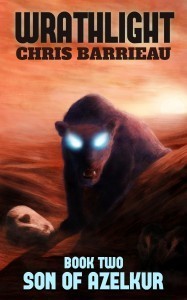 Wrathlight: Son of Azelkur by Christopher Barrieau
Wrathlight: Son of Azelkur by Christopher Barrieau
Scott Shaw, hero of the arena, finds himself on the frontlines of a war against the evil Bathel. An Alliance of liberated races and Humanity has formed, and guided by the mighty Warlord, is driving back The Bathel toward their homeworld.
But as the Alliance wins victory after victory, Scott finds himself in a different kind of arena – of clashing personalities and corrupt allies, of exotic cultures and lethal taboos.
And when Warlord departs, Scott finds himself facing down a deadly, vengeful enemy and a hideous Son of the dark god Azelkur. If he should fail, it means death for an entire world, his mentor Felix, his men, and himself.
Wrathlight: Son of Azelkur is 43,000 words and is the sequel to Wrathlight.
 The Heart Thief by S. Lee Benedict
The Heart Thief by S. Lee Benedict
Ezra Keene is an artistic sixteen year-old who wants nothing more than to settle in at his new school and put the tragedy of his brother’s death behind him. He awakens one night, reeling from a hazy dream, to find his fingers blackened with pencil lead and a new drawing in his sketchbook—a drawing that depicts the grisly murder of someone he knows. The next morning he is shocked to learn the picture has become a reality.
Ezra has reason to believe the father of a classmate, an eccentric German scientist, is somehow involved in the slaying, but he needs something tangible to bring to the police. He sets out to discover the truth, but what he finds instead is that something much more sinister than murder lies at the heart of this mystery. Monsters exist, magic is real, and sometimes there are worse things than death.
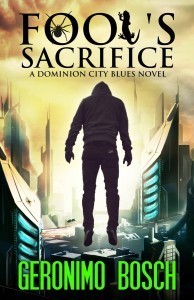 Fool’s Sacrifice by Geronimo Bosch
Fool’s Sacrifice by Geronimo Bosch
DOMINION: A lawless city of ten million desperate souls. The State ignores the struggles of the dispossessed, but crushes any who challenge its rule.
G-Boy is a delinquent graffiti artist and ace pilot working the airborne auto theft trade who finds his life threatened when he teams up with a slick newcomer, a girl named Spider. She’s tech savvy and scopes all the angles, but comes wrapped in a web of secrecy and bad luck. After they lift a haul of booby-trapped vehicles and their partners in crime are blown from the skies, they find themselves under suspicion from their gangland boss and painted as terrorists by the authorities who govern Dominion City.
As the net tightens around them, G-Boy is presented with a dilemma. Face punishment for his crimes or accept a fool’s sacrifice by taking the hand of a mysterious stranger offering escape. But, at a price.
2012: NASA’s Curiosity Rover lands on Mars to search for signs of whether microbial life existed on the planet.
2018: The first alien lifeform, a simple wormlike creature is discovered, gripping the world’s imagination.
2022: The first manned mission to Mars begins the longest and most dangerous journey ever undertaken by humankind.
From hundreds of potential candidates, six astronauts from countries around the world are selected to crew the historic mission. Led by Commander Samantha Collins, they must travel across the gulf of interplanetary space, over 150 million miles from home and help. Their mission is to investigate alien life, but what they discover is far beyond what anyone ever imagined…
Revi is an assassin on her first assignment–and she’s not willing to kill a child.
When she goes on the run from her assassin brotherhood with a knife that opens doors between worlds, she runs afoul of three factions: inter-world police, the other assassins, and a shrewd bounty hunter named Jacob Argent.
And he’s the only one interested in keeping her alive.
Now unwillingly allied with Jake, Revi flees across the war-torn world of Tyrona. Against a backdrop of warring factions on floating continents battling via zeppelins, robot suits, and flying monsters, she tries to survive being both pawn and prize in a cosmic chess game between two mega-chronomancers. But worst of all, she’s developing feelings for Jake–her enemy.
Jacob Argent is a lonely bounty hunter on an assignment–locate the missing person known as Revenant. But when he locates her, he must protect her from the assassins and police–and the growing attraction of his own heart.
Now Jake must work through his grief over his dead fiance, before Revi is lost to him forever. Because his actions have earned him the personal hatred of a super-mage called the Oracle, who means to kill Jake any way he can.
This is book 3 of the Spacetime Legacy series, following Storm Chase and Chronocrime.
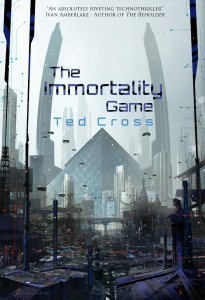 The Immortality Game by Ted Cross
The Immortality Game by Ted Cross
Moscow, 2138. With the world only beginning to recover from the complete societal collapse of the late 21st Century, Zoya scrapes by prepping corpses for funerals and dreams of saving enough money to have a child. When her brother forces her to bring him a mysterious package, she witnesses his murder and finds herself on the run from ruthless mobsters. Frantically trying to stay alive and save her loved ones, Zoya opens the package and discovers two unusual data cards, one that allows her to fight back against the mafia and another which may hold the key to everlasting life.
 The Brigadoon Boondoggle by Robert Dahlen
The Brigadoon Boondoggle by Robert Dahlen
“I have to help them. All of them. It’s why I do this.”
Michiko, the hero known as the Monkey Queen, and geek girl Beth McGill thought it would be easy. They’ve become good friends since they started working together to save the world, why not become roommates? Of course, that was before the kitchen fire. And the broken bedroom door. Not to mention the cranky guinea pig.
But they have bigger problems ahead. A shady real estate deal has left two new groups of Emigres arguing over a meadow. Other Emigres are vanishing without a trace. And enemies old and new lurk in the woods, in the shadows, even in dreams.
Can Michiko and Beth stop the darkness…or will they be the next victims?
The is book two of the Monkey Queen series, following Of Introductions And Abductions
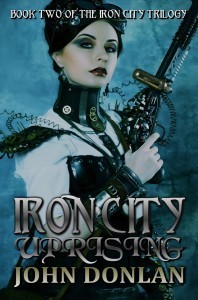 Iron City Uprising by John Donlan
Iron City Uprising by John Donlan
Trapped in the sprawling ruins of the Warren, the rebel fighters of the Fist, led by Abigail Cunningham, are slowly being hunted down by Lucian and his brutish Iron Hand thugs. If they are to survive to see their rebellion, the Fist must devise a plan that is both daring, and dangerous.
Meanwhile, Abel, determined to find out the truth about his past, returns to the Skein, where he uncovers something that will not only shake the foundations of his world, but will bring the city closer to the brink of chaos.
With time running out, and a horrific plan about to be enacted, a chance meeting in the Heights will spell the difference between destruction, and the hope of a new beginning.
This is the sequel to Iron City Rebels.
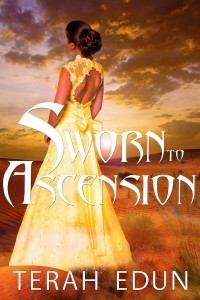 Sworn to Ascension by Terah Edun
Sworn to Ascension by Terah Edun
Ciardis Weathervane is officially engaged to one man and bonded to a second. She should be planning the wedding ceremony, bearding the nobles of the imperial court in their dens, and exposing an imposter emperor. Instead she’s spending her engagement on the lawless road to the western lands.
Now with the help of a guide from a tribe of seers, Ciardis is traveling to the ancient city of Kifar. Rumored to hold the only device capable of stopping the blutgott, Ciardis, Sebastian and Thanar must break a half-century’s old quarantine in order to enter the fabled city.
But the collar of Diamis is not the only thing they seek. The princess heir’s pet wyvern lurks in wait for them and the emperor, who has done everything short of challenging the new triad of Algardis outright, wants its head on a platter upon their return.
If the unscrupulous bandits don’t make short work of them, Ciardis knows that she and Sebastian will have to a face and unmask the man who has stolen the imperial throne. The only question that remains…will that be before or after they’re forced to battle a god?
The sixth novel in the Courtlight series continues the story of Ciardis Weathervane from Sworn To Defiance.
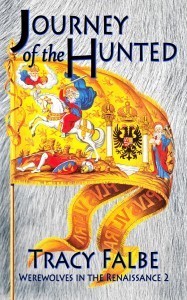 Journey of the Hunted by Tracy Falbe
Journey of the Hunted by Tracy Falbe
Facing uncertain destinies, Thal and Altea must escape Bohemia. The Holy Roman Emperor Ferdinand himself has signed the warrant for Thal’s capture on charges of shape shifting and the killing of Jesuits.
A hefty reward attracts countless bounty hunters into the heart of this 16th century Christian empire. Thal emerges from hiding with his young wife Altea who is barely recovered from torture at the hands of witch hunters. With his werewolf powers, he battles the bounty hunters and begins a daring journey across the Holy Roman Empire.
But more than men stalk him. Servants of Tekax, sorcerer to the Turks, have been unleashed upon his trail.
The werewolf Rotfeng covets the enchanted fur that lets Thal change form at will, regardless of the phase of the moon.
Worse yet comes Janfelter, an undying fext created in the dark fortress of Tekax.
These heartless killers are tasked with stopping Thal from reaching his father Sarputeen, the arch nemesis of Tekax. Thal’s only refuge awaits him in what is left of the Kingdom of Hungary after a Turkish conquest. In the remote castle Vlkbohveza the ancient sorcerer Sarputeen lives untouched despite widespread persecution of magic users and pagans.
Although Thal longs to be with his own kind, he worries about the reunion with his father. It was Sarputeen’s magic that made Thal a werelord, a master of wolves. But what shall the sorcerer require of his creation now that Tekax aims to settle an old score?
This is book two of the Werewolves in the Renaissance series, following Werelord Thal.
Kate has escaped from the facility. She reaches out to Max and reveals the secret she has been protecting for years, the secret that Orion so desperately wants to contain. Friendships and relationships are tested as they pit themselves against an army of genetically modified super soldiers controlled by the most powerful man in Egalia. But a greater truth is yet to be revealed. One that ties all their fates together. Will it all come crashing down?
This is book 2 of the Egalia series, following The Genetic Lottery.
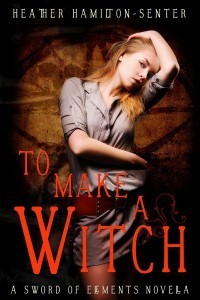 To Make a Witch by Heather Hamilton-Senter
To Make a Witch by Heather Hamilton-Senter
On December 17th, 2013, a vandal painted the tomb of Marie Laveau—the famed Voodoo Queen of New Orleans — bright pink. It is believed that the vandal’s intent was to cover the X marks that had been scratched into the tomb. This story takes place just after that event.
At her old high school, Lacey found herself on the wrong side of a conflict between Celtic gods. Making a new start in an exclusive boarding school in New Orleans, she hopes to forget that she was once on the verge of becoming a powerful witch—and everything she’s lost both since and before then.
When a gruesome murder occurs in the very heart of Westover Academy, Lacey discovers a connection between it and the desecration of the tomb of Marie Laveau, the famed Voodoo Queen. Haunted by a trauma in her past, Lacey must solve the mystery before she becomes the killer’s next target.
Circumstances beyond her control may once again make Lacey McInnis — cheerleader, scholar, and all-around good girl — a witch.
To Make A Witch is a novella featuring the enigmatic Lacey McInnis from Bound In Blue: Book One of the Sword of Elements series.
Master Sergeant Gant Maker was a highly-decorated and well-respected Marine – until his last mission left him as the sole survivor of an encounter with a vicious race called the Vacra. Served up as a scapegoat and drummed out of the military, he has since lived a life of seclusion with only an adopted alien as a companion.
Now the Vacra have returned. As the only person to have ever faced them and survived, Maker is reinstated in the Corps and given the onerous task of finding this enemy on a world located at the edge of known space. Assisting him is an unlikely band of military rejects, including a blind sharpshooter, an unstable psychic, and a genetically-engineered killing machine who refuses to fight.
Given that the Vacra have superior weapons and technology, Maker recognizes that his team is at a distinct disadvantage. But Marines are nothing if not resourceful, and Maker has an audacious plan that just may level the playing field – if it doesn’t get them all killed.
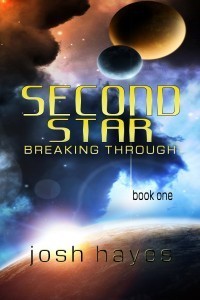 Second Star: Breaking Through by Josh Hayes
Second Star: Breaking Through by Josh Hayes
Sixty-six days is all pilot John McNeal has left on his service contract, after that his combat days will be over for good — if he survives that long.
After a mysterious rift in the fabric of spacetime strands him on an alien world, John must join forces with some unlikely childhood heroes to have any chance of surviving and soon discovers that this strange new world isn’t that alien after all.
Someone has been here before and found a way back to tell about it. There is hope, but this is not the fairy tale he knows and John will have to fight if he wants to get home.
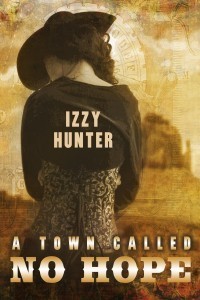 A Town Called No Hope by Izzy Hunter
A Town Called No Hope by Izzy Hunter
Mona Miller would agree that her life is not too shabby. Sheriff of a prosperous mid-west settlement and with her mute lover Henry by her side, it’s a far cry from her wild antics back in England.
But after an ill-advised bank robbery goes wrong, Mona pursues the thief, via airship, to the city of New Moray. There she catches the culprit and plans to bring him back to face the music. So far, so easy.
But what isn’t so easy is dealing with a criminal mastermind who spends his time controlling his illegal activities in an underground labyrinth. Nor with a handsome stranger who just wont leave her side.
And when she finally returns to No Hope, what she finds there could destroy the very life she has carefully built for herself and those that she loves.
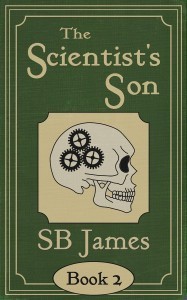 The Scientist’s Son by SB James
The Scientist’s Son by SB James
Ethan Stanwood may have prevailed over dangerous foes before, but his troubles are just beginning.
Ethan arrives in Rome, but a number of his enemies appear there as well, Professor Colbourne being among them. Colbourne is still intent on getting the prototype that Ethan has been tasked with protecting and returning to his father. But his father’s actions and secrets catch up to Ethan, causing chaos and danger wherever he goes.
It is not only Ethan’s father whose life has been shrouded in secrecy, but his deceased mother as well. A man who is a friend of his mother’s side of the family has returned to help Ethan, presumably at the behest of the Order of the Crystal Star. He says his intentions are pure, but his actions may just prove otherwise, with terrible consequences.
And in the shadows, Aloysius Hardwick, who seeks to turn Ethan to the darkness, discovers that he is not the only one of his kind with the same intentions. To protect his claim on the Stanwood family, Hardwick will go to any lengths, and kill anyone necessary, to keep Ethan in his eventual control.
The Scientist’s Son is Book 2 of the paranormal Steampunk series started with The Inventor’s Son.
Also, don’t miss The Inventor’s Son: The Beginning, an introduction to a Victorian London that could have been.
Dan Jenkins is back, body hopping a scumbag at a time in his quest for the perfect ride. He doesn’t need much. Premium cable TV, good books, a well-stocked pantry, and he’s set. But the Great Whomever has other plans.
After six months waiting in limbo, Dan catches a ride as a horror novelist whose gruesome stories aren’t just fiction. Later, he hunts a man who’s escaped justice for far too long. Then, in his greatest challenge yet, he strays too deeply into the lives of the people he loves: his most foolish ride of all.
This is the sequel to Kick.
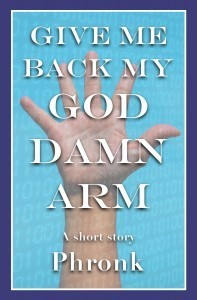 Give Me Back My God Damn Arm by Phronk
Give Me Back My God Damn Arm by Phronk
When Ford wakes up to find his favorite arm missing, he knows he doesn’t have long before years of progress slip through his fingers. Can he get it back? On one hand, the old cop in charge of the investigation doesn’t believe Ford had a third arm in the first place. On the other hand, his young partner has a good grasp on the latest digital tracking technology. All they need to gain the upper hand is to point out who would want to steal Ford’s God damn arm in the first place.
Give Me Back My God Damn Arm is a weird 4000 word (16 page) short story.
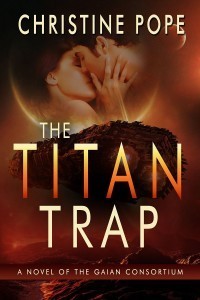 The Titan Trap by Christine Pope
The Titan Trap by Christine Pope
Cassidy Evans inherited the Titan run when her father died and left her a broken-down cargo transport and a regular gig hauling supplies to the maximum-security prison located on Jupiter’s moon. When convicted murderer Derek Tagawa hijacks her ship and demands her help in clearing his name, Cass can’t help but wonder if there aren’t easier ways to make a living. But Derek has those amazing…eyes…and she begins to believe there may be more to his story than she originally thought.
Running from the authorities, they head to the heart of Gaia to unearth a conspiracy so far-reaching that exposing it could rock the Consortium to its very foundation… and change the future course of both their lives.
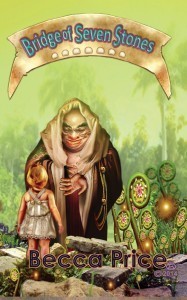 Bridge of Seven Stones by Becca Price, illustrated by Sara Anderson
Bridge of Seven Stones by Becca Price, illustrated by Sara Anderson
“I’m not a baby!”
“Prove it!”
A child leaves the safety of the Garden of the Morning and begins exploring the Gardens of Growing Up.
The Bridge of Seven Stones is a story about losing teeth, and growing up. An alternative to the Tooth Fairy story, it recognizes the losses of familiar ways and things, and shows how each new stage leads to new and wonderful discoveries.
This book was was designed to give parents an idea, an alternative to the tooth-fairy story, a way to celebrate the loss of a baby tooth and to prepare the child for the transitions that come with growing up. This story was designed to be read to help a child proclaim:
“I’m not a baby anymore.”
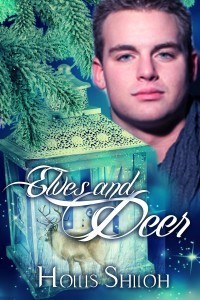 Elves and Deer by Hollis Shiloh
Elves and Deer by Hollis Shiloh
Greer is a reindeer shifter working at a magical shipping hub up North. He has little use for or understanding of elves—such delicate, short-lived creatures—but he tries to do his best by the ones in his life. And it seems like more and more are coming into his life, confusing and frustrating him, needing help, needing rescued.
Since Greer is always busy, it’s easy to overlook the things he doesn’t want to acknowledge—until a terrible danger gives him unwanted time to think…and to realize there’s just one elf who means more to him than he’s ever wanted to admit.
A Christmas tale
38,000 words
Heat level: very low
For centuries, Phil Stark has been the keeper of the machine that changed the world–a lighthouse keeper–guilt-ridden, impossibly alone and losing his mind, the machine is his penance for what he had done centuries before.
When Phil meets Isla, he finds a kinship that he didn’t think could be possible. And when he crosses paths with Sammi and Declan, he believes that his life, and the fate of the world, might just change forever.
Union is the final book in the Gray Series. In this installment, Declan finds the answers he’s sought since first seeing the chalky letters spelling out the words: End of Gray Skies. With Sammi and his father and Ms. Gilly, they team up with an unlikely partner in one final attempt to rescue the sunlight and bring it back to their world.
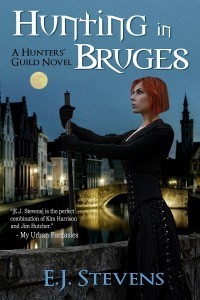 Hunting in Bruges by E.J. Stevens
Hunting in Bruges by E.J. Stevens
The only thing worse than being a Hunter in the fae-ridden city of Harborsmouth, is hunting vamps in Bruges.
Being shipped off to Belgium sucks. The medieval city of Bruges is quaint, but the local Hunters’ Guild is understaffed, the canals are choked with dead bodies, and there’s no shortage of supernatural predators as likely suspects.
On second thought, maybe Bruges isn’t so bad after all.
With a desire to prove herself, protect the innocent, and advance within the ranks of the Hunters’ Guild, Jenna Lehane hits the cobbled streets of Bruges with blades at the ready. Someone, or something, is murdering tourists and dumping their bodies in the city’s scenic canals. With the help of a mysterious stranger, Jenna begins to piece together clues that are dotted throughout the city like blood spatter.
Determined to stop the killings, Jenna delves into a bloody local history that only raises more questions–but some secrets are best left buried. Jenna must put her combat training to the test as she struggles to unearth the truth about an ancient enemy.
Hunting in Bruges is the first novel in the Hunters’ Guild urban fantasy series set in the world of Ivy Granger.
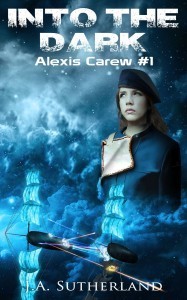 Into the Dark by J.A. Sutherland
Into the Dark by J.A. Sutherland
At fifteen, Alexis Carew has to face an age old problem – she’s a girl, and only a boy can inherit the family’s vast holdings. Her options are few. She must marry and watch a stranger run the lands, or become a penniless tenant and see the lands she so dearly loves sold off. Yet there may be another option, one that involves becoming a midshipman on a shorthanded spaceship with no other women.
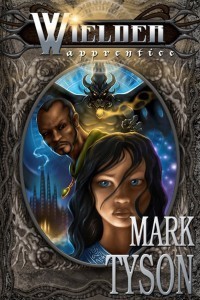 Wielder: Apprentice by Mark Tyson
Wielder: Apprentice by Mark Tyson
The making of a legend…
Sheyna Namear believes she has been left to fend for herself on the streets of the notoriously corrupt city of Symbor. She has very little memory of her life prior, and she is forced to steal what she can to survive. When her natural ability to enchant everyday items eventually catches the eye of a powerful magic wielder, Sheyna is taken into the woman’s tower as an apprentice. But something is not quite right. Sheyna constantly feels like she is being watched, her roommate hates her, and a mysterious shadow hides in the darkness outside her window.
Book One of The Wielder Cycle.
Bramen Hold triumphantly survived the city of Hyll’s grimy underworld. But the victory was short-lived. Now Bramen finds himself in the custody of the High Command who’s taken notice of his abilities. Convinced he may be cut out for a secretive special mission, an official with the High Command throws Bramen into a horrific gauntlet and proving ground known as The Grim. With the lives of his family and friends hanging in the balance, Bramen is forced to face his greatest fears until a secret is revealed that changes everything.
This is part 2 of the Cannibal Collapse series, following The Clone Rules.
 Alpha’s Heart Part 1 and Part 2 by Skye Winters
Alpha’s Heart Part 1 and Part 2 by Skye Winters
Surrendering her heart to the woman she loves could cost the pack their lives.
The laws within the boundary are painstakingly clear. Alphas mate with alphas to keep peace between the packs and the veil hiding their existence in place.
Anna’s determined to pass pack leadership to her brothers in order to share her bond with Rowan—the she-wolf who effortlessly stole her heart. But with her mother’s health and their population in decline, staying true to her bond might just be the biggest challenge of all.
These are the first two parts of a lesbian shifter serial and contains scenes not suitable for those under the age of eighteen.
 Send to Kindle
Send to Kindle
Cora Buhlert's Blog
- Cora Buhlert's profile
- 14 followers


